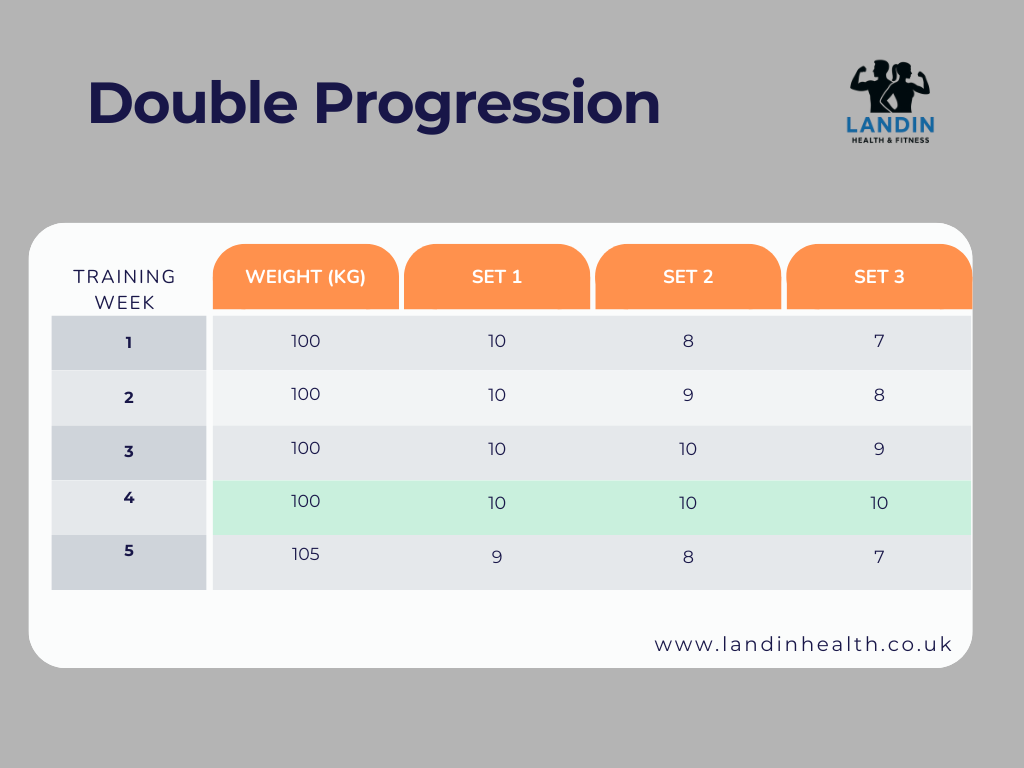What Is The Best Type Of Progressive Overload?
Progressive overload is essential to gaining muscle and strength. It prevents plateaus and ensures consistent results. So if you’re not applying progressive overload to your training, you’re leaving gains on the table.
What is The Meaning Of Progressive Overload?
In simple terms, it is gradually increasing the stress on the body and it can be done in numerous ways. It is not just lifting more weight than last time.
Progressive overload can also be achieved by: adding a set, rep, exercise, session or even just slowing your reps down.
Now these methods do not need any further explanation. However, you may be reading this article to find out what is the best method of implementing progressive overload and when you should do it.
Let me explain my favourite methods
Double progression is one of the most basic methods you can use and great for any beginner to use on most of their lifts. The way you progress up the weights only when you can perform all the target reps of a certain weight for all your working sets. On the example above the target reps are 10 and 3 working sets. You can see on the 4th week, 10 reps were hit on all 3 sets so therefore you move up a weight.
If you’re just starting out, this is a great method to begin with and you want to select a weight that you think you can do your target reps with plus an extra one or two. This will give you a good benchmark to start.
A downside to this method can be sometimes you may feel that the first set isn’t hard enough and you have the urge to train to failure. Just trust the process. If you’re moving up weights, then you’re in a good spot.
However, sometimes you can feel like you are stagnant and on your final set you just can’t seem to hit your target rep for the past few weeks and it is frustrating you. Here’s where you can try out Dynamic Double Progression.
Dynamic Double Progression is a great method to help switch up your training a bit. It differs from Double Progression because you don’t need to hit your target reps on all your sets, just one set and then you increase the weight on that specific set.
If you look above, on week one set 1, 10 reps were performed only on the first set. This means that on week two, the weight has been increased from 100kg to 105kg but only on that first set. On the remaining sets, the weight stays at 100kg until 10 reps is achieved on that set.
This method can lead to scenarios like week 6 above where your first set becomes a lot higher than your second and third (115,105,105) because you’re going to complete failure on the first set and leaving next to nothing in the tank on the remaining sets. This isn’t a problem, however if the gap becomes larger and larger, start going and extra rep or two away from failure on the first set and you will see the remaining sets improve.
If you prefer a less rigid approach, the rep goal system may be your cup of tea.
The Rep Goal method is one of my personal favourites. Pick a target amount of reps to hit over a certain amount of sets and the goal is to hit those reps in any sequence possible. Above you can see in week 4 the rep goal of 30 was hit by doing 12,10,8. There is no rule how to hit the goal. It could have been done by doing 13,10,7 as well.
My preferred way of managing the goal over the sets if I’m doing 3 is to go 1/2 reps from failure on the first set, 1 rep from failure on the second and all out failure on the third. If you feel like you are going to hit the rep goal on your final set but still have a rep or two in you, still do them. Don’t just stop lifting because you’ve hit your goal.
Once you increase the weight, keep the same rep goal for your next session and you may be a few reps short which is fine. Even adding one rep over multiple sets per week is still great progress over the whole year. If you increase the weight and feel like you’re going to be nowhere near the rep goal on your final set, decrease the weight and get the reps in.
The Back Loading method ensures you’re going to get the reps in at your working weight in a controlled manner. You start with a rep goal and make sure that you are picking a weight that you can definitely do a set of your target goal for it.
In the example above you will see the rep goal is 8. The philosophy of back loading is that you only increase your working set weight when you are able to hit your rep goal + 2 reps on your final set. This is achieved on week 4.
This method allows you to practice quality controlled reps on your first two sets without going close to failure. You may feel you increase the weight at a slower rate than some other methods. However this method is great for managing fatigue whilst also getting great muscle stimulus, mainly on your final set that you want to take to failure, going for as many reps as possible.
If you want a progressive overload method that increased weight on the bar week on week, the 8/5/3 method may be for you.
The 8/5/3 method is a progressive overload method I got from my previous coach Fazlifts. It’s an alteration on the Jim Wendler’s 5/3/1 method.
At first this may look complicated, but it is super easy to understand.
Week 1, pick a weight that you can do 3 sets of 8 reps with. From there, you will increase the weight by the smallest increment possible until you can no longer do 3 sets of 8. This will usually come in the form of performing 8,8,7. Even though you failed the lift for 3 sets, the following session you still at weight but you perform 8 reps for 2 sets, not 3.
As you can see in the diagram above, you repeat this process week on week adding weight every week until you get to the point of not being able to perform 8 reps for 1 sets (week 6). Now you go back to 3 sets, but the rep goal of 5 reps.
Now you repeat the same process until you can no longer do 5 reps for 1 set, and you move onto 3 reps for 3 sets. When you’ve got the the point of only managing 2 reps, return back to 8 reps for 3 sets at the weight you failed at. So in the example above, they would return to performing 102.5kg for 8 reps and 3 sets.
Providing all your other aspects of training are in a good spot (consistency, eating, sleep), you will smoke the weight you previously failed.
I love this method because you’re adding weight to the bar every week and it makes every session feel fresh because it’s not the same weight over and over again. It also means you are training a lift in multiple rep ranges over time.
If you feel like 1 set is too low in volume when you get to that point, sometimes I like to drop the weight by 10/20% and hit as many reps as possible.
Final Thoughts
Progressive overload is the backbone of making progress in the gym — without it, your body has no reason to adapt. The methods I’ve walked through (double progression, dynamic double progression, rep goal, back loading, 8/5/3) are all effective ways to apply it, and which one you use will depend on your goals, training style, and personality. But which one is the best? The one you enjoy the most and keeps you motivated to go to the gym consistently and put the work in.
But remember: adding weight to the bar only counts if your form is still solid. Reducing your range of motion isn’t true strength progression — it’s just cheating yourself. That’s why I always recommend doing a form check every now and then, whether that’s recording yourself, asking a training partner, or getting a coach’s eye on your lifts.
If you want structured programming, accountability, and feedback to make sure your progression is actually building muscle and strength the right way — that’s where I come in. My coaching takes the guesswork out of training, keeps you progressing week after week, and makes sure your form and programming are spot on.
Get in touch with me using the form below





